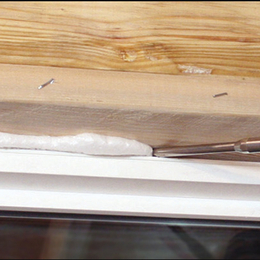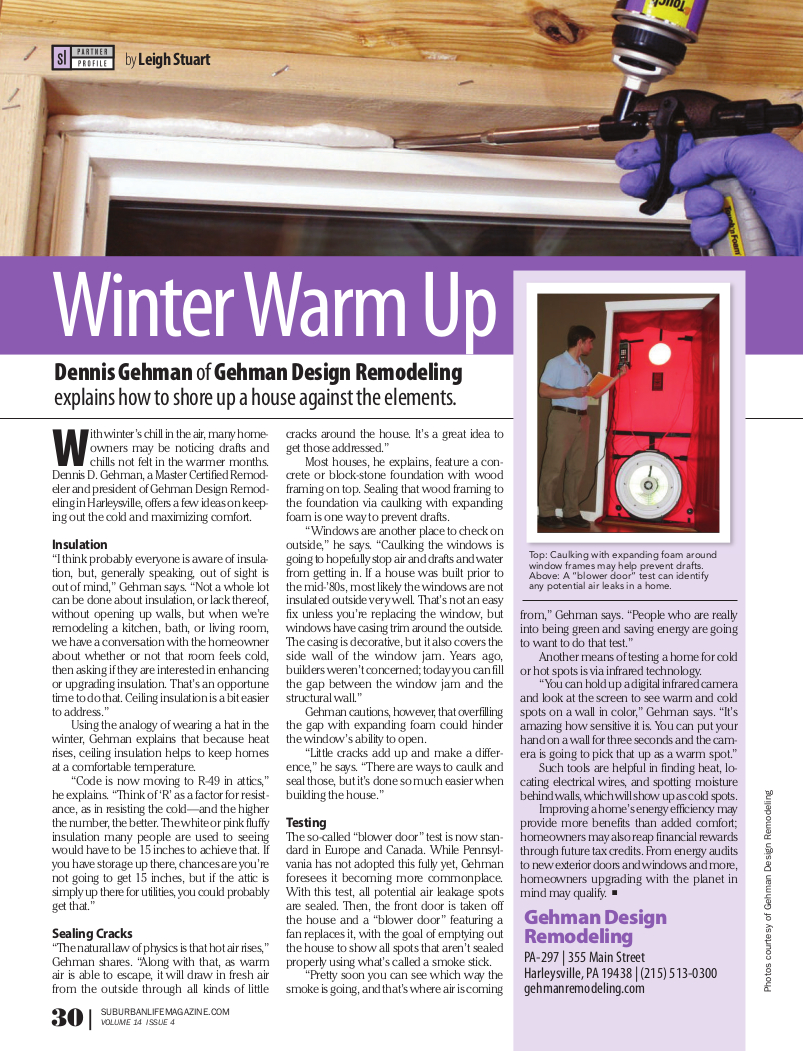
Winter Warm Up
Dennis Gehman of Gehman Design Remodeling explains how to shore up a house against the elements.
With winter’s chill in the air, many homeowners may be noticing drafts and chills not felt in the warmer months. Dennis D. Gehman, a Master Certified Remodeler and president of Gehman Design Remodeling in Harleysville, offers a few ideas on keeping out the cold and maximizing comfort.
Insulation
“I think probably everyone is aware of insulation, but, generally speaking, out of sight is out of mind,” Gehman says. “Not a whole lot can be done about insulation, or lack thereof, without opening up walls, but when we’re remodeling a kitchen, bath, or living room, we have a conversation with the homeowner about whether or not that room feels cold, then asking if they are interested in enhancing or upgrading insulation. That’s an opportune time to do that. Ceiling insulation is a bit easier to address.”
Using the analogy of wearing a hat in the winter, Gehman explains that because heat rises, ceiling insulation helps to keep homes at a comfortable temperature.
“Code is now moving to R-49 in attics,” he explains. “Think of ‘R’ as a factor for resistance, as in resisting the cold—and the higher the number, the better. The white or pink fluffy insulation many people are used to seeing would have to be 15 inches to achieve that. If you have storage up there, chances are you’re not going to get 15 inches, but if the attic is simply up there for utilities, you could probably get that.”
Sealing Cracks
“The natural law of physics is that hot air rises,” Gehman shares. “Along with that, as warm air is able to escape, it will draw in fresh air from the outside through all kinds of little cracks around the house. It’s a great idea to get those addressed.”
“The natural law of physics is that hot air rises,” Gehman shares. “Along with that, as warm air is able to escape, it will draw in fresh air from the outside through all kinds of little cracks around the house. It’s a great idea to get those addressed.”
Most houses, he explains, feature a concrete or block-stone foundation with wood framing on top. Sealing that wood framing to the foundation via caulking with expanding foam is one way to prevent drafts.
“Windows are another place to check on outside,” he says. “Caulking the windows is going to hopefully stop air and drafts and water from getting in. If a house was built prior to the mid-’80s, most likely the windows are not insulated outside very well. That’s not an easy fix unless you’re replacing the window, but windows have casing trim around the outside. The casing is decorative, but it also covers the side wall of the window jam. Years ago, builders weren’t concerned; today you can fill the gap between the window jam and the structural wall.”
Gehman cautions, however, that overfilling the gap with expanding foam could hinder the window’s ability to open.
“Little cracks add up and make a difference,” he says. “There are ways to caulk and seal those, but it’s done so much easier when building the house.”
Testing
The so-called “blower door” test is now standard in Europe and Canada. While Pennsylvania has not adopted this fully yet, Gehman foresees it becoming more commonplace. With this test, all potential air leakage spots are sealed. Then, the front door is taken off the house and a “blower door” featuring a fan replaces it, with the goal of emptying out the house to show all spots that aren’t sealed properly using what’s called a smoke stick.
The so-called “blower door” test is now standard in Europe and Canada. While Pennsylvania has not adopted this fully yet, Gehman foresees it becoming more commonplace. With this test, all potential air leakage spots are sealed. Then, the front door is taken off the house and a “blower door” featuring a fan replaces it, with the goal of emptying out the house to show all spots that aren’t sealed properly using what’s called a smoke stick.
“Pretty soon you can see which way the smoke is going, and that’s where air is coming from,” Gehman says. “People who are really into being green and saving energy are going to want to do that test.”
Another means of testing a home for cold or hot spots is via infrared technology.
“You can hold up a digital infrared camera and look at the screen to see warm and cold spots on a wall in color,” Gehman says. “It’s amazing how sensitive it is. You can put your hand on a wall for three seconds and the camera is going to pick that up as a warm spot.”
Such tools are helpful in finding heat, locating electrical wires, and spotting moisture behind walls, which will show up as cold spots.
Improving a home’s energy efficiency may provide more benefits than added comfort; homeowners may also reap financial rewards through future tax credits. From energy audits to new exterior doors and windows and more, homeowners upgrading with the planet in mind may qualify.
Gehman Design Remodeling
PA-297
355 Main Street
Harleysville, PA 19438
(215) 513-0300
gehmanremodeling.com
PA-297
355 Main Street
Harleysville, PA 19438
(215) 513-0300
gehmanremodeling.com
Photo courtesy of Gehman Design Remodeling
Published (and copyrighted) in Suburban Life, December 2022.



